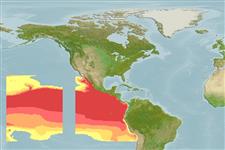Common names from other countries
>
Beryciformes (Sawbellies) >
Melamphaidae (Bigscale fishes or ridgeheads)
Etymology: Melamphaes: Greek, melan, -anos = black + Greek, amphi = both side (Ref. 45335).
Environment: milieu / climate zone / depth range / distribution range
Écologie
marin bathypélagique; profondeur 62 - 500 m (Ref. 51657). Deep-water; 30°N - 23°S, 120°W - 130°W (Ref. 87970)
Eastern Pacific Ocean: tropical, endemic to ETP, from the California coast (ca. 30°N) down to northern Chilean coast (ca. 23°S).
Taille / Poids / Âge
Maturity: Lm ? range ? - ? cm
Max length : 12.8 cm SL mâle / non sexé; (Ref. 87970)
Description synthétique
Clés d'identification | Morphologie | Morphométrie
Épines dorsales (Total) : 3; Rayons mous dorsaux (Total) : 13 - 16; Épines anales: 1; Rayons mous anaux: 8; Vertèbres: 27 - 28. The species is characterized by the following: large head (more than 40% of SL, specimens of SL ? 100.0 mm); first gill arch with 20-22 rakers; total vertebrae 26-28, 11 abdominal; haemal arch of the first caudal vertebra is without a spur; D III,13-16; P14-15; ventral fin with 7 soft rays; ventral fin starts before the vertical line of the posterior margin of the pectoral fin basement; anal fin starts under the vertical line of the 3-4 ray of the dorsal fin (posterior end); operculum with 4 scales (Ref. 87970).
Adults caught below 400-500 meters; juveniles in shallower water (Ref. 51657). Specimens were sampled by open-mouth nets at depth range of 1500-0 m; the minimal sampling depth was 62 m (individuals with SL = 12.7-13.3 mm) (Ref. 87970).
Life cycle and mating behavior
Maturities | Reproduction | Spawnings | Egg(s) | Fecundities | Larves
Kotlyar, A.N., 2011. Revision of genus Melamphaes (Melamphaidae). II. Multi-raker species: M. polylepis, M. falsidicus sp. nova, M. pachystomus sp. nova, M. macrocephalus, M. leprus. J. Ichthyol. 51(8):658-661. (Ref. 87970)
Statut dans la liste rouge de l'IUCN (Ref. 130435)
CITES (Ref. 128078)
Not Evaluated
Menace pour l'homme
Harmless
Utilisations par l'homme
Outils
Articles particuliers
Télécharger en XML
Sources Internet
Estimates based on models
Preferred temperature (Ref.
115969): 12.1 - 14.8, mean 13.2 (based on 26 cells).
Phylogenetic diversity index (Ref.
82804): PD
50 = 0.5000 [Uniqueness, from 0.5 = low to 2.0 = high].
Bayesian length-weight: a=0.01096 (0.00451 - 0.02668), b=3.10 (2.89 - 3.31), in cm Total Length, based on LWR estimates for this (Sub)family-body shape (Ref.
93245).
Niveau trophique (Ref.
69278): 3.7 ±0.2 se; based on size and trophs of closest relatives
Résilience (Ref.
120179): Faible, temps minimum de doublement de population : 4,5 à 14 années (Preliminary K or Fecundity.).
Fishing Vulnerability (Ref.
59153): Low vulnerability (10 of 100).
